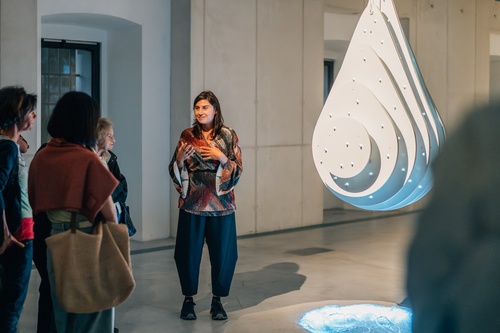Saša Spačal

In The Library of Fallen Tears exhibition, Spačal continues her exploration of human corporality relative to the environment and the interspecific characteristics of all living beings.
Saša Spačal’s artistic practice focuses on exploring the biochemical circulation of matter on the planet, especially in the context of the microorganisms that share our bodies. In The Library of Fallen Tears exhibition, Spačal continues her exploration of human corporality relative to the environment and the interspecific characteristics of all living beings. By doing so, Spačal aims to view the human body – which is composed of almost two-thirds water – as a body of water and thus part of the hydrological cycles of water: never still or isolated but in a process of constant rearrangement and readjustment. As a result, the artist revives the concept of the hypersea, with the central idea that all organisms on the Earth’s surface are connected in a network of “sea on land”. We are all, then, “bags of water” who, by crossing over to land, have taken the sea with us, and water is the element that interconnects all bodies, making them interdependent.
Can we imagine our tears as an environment in which other beings live? Tears, as part of our microbiome, are also alive, as their micro-ecosystem contains not only enzymes, lipids, electrolytes, proteins, and hormones, but bacteria as well. Using the elements and properties of tears, Spačal created the story of an abandoned and lonely girl, Namida Ikita (Jap. “Living Tear”), who discovers that the path of life constantly oscillates between crying and laughing, which both give rise to tears. Namida collects her tears, dries the microbes in them and stores them above a pool of water, the elemental factor that makes their revival possible. When she recognises that she is never alone while she is crying but is always part of hydrological cycles in which human beings, along with other forms of life, are involved in a complex relationship between giving and receiving, she decides to build a sanctuary. While observing changes in nature, such as the accumulation of water where it has always been abundant and its disappearance where it has always been scarce, she realises that it is absolutely vital to protect the living tears in the creation of hybrid creatures capable of surviving in extreme conditions.
The first stop in the exhibition features The Library of Fallen Tears: a luminous teardrop-shaped object filled with ampoules of tear microbiomes and a pool containing glass sculptures of bacteria. This is followed by The Shrine of Living Tears, a tear collector, where visitors can donate their tears to the installation and receive an audio signal in response to their donation. Conductivity and motion sensors installed in the tear collector detect a tear that has been donated, choreographing it into a donation ritual accompanied by an audio response. After the exhibition comes to an end, the artist will dry the collected tears and store them in ampoules, which will then become part of The Library of Fallen Tears. The third stop features The Monsters of the Hypersea, a glass sculpture placed in a river of sand that connects the entire exhibition. The sculpture contains hybrids of eye bacteria and Deinococcus radiodurans, one of the most resistant polyextremophiles. The stops along the river are completed with three videos telling Namida’s story.
As noted by the philosopher Donna Haraway, it matters which stories we tell and how we tell them. The stories that Saša Spačal reveals are always poetic narratives that nurture interspecific connections, the ethics of responsibility and care, as well as a better way of co-existing with the different planetary bodies that keep us alive. These projects, which are part of the emerging series, How We Never Cry Alone, manage to do so by using the bodily fluid with which we show our own vulnerability. The tears, which give rise to communities of Others, become a metonymy for the human microbiome, which is currently undergoing intentional and unintentional hybridisations in the face of climate and environmental changes, and for the bodies of water that connect pockets of the hypersea across continents and biological species. They at once remind us of the primordial seas where life began and of our own gestation period as embryos swimming in amniotic waters. Moreover, the microbiome we carry in us – and with us – assumes its own role as a witness to our shared evolutionary journey through space and time.
Curated by Alenka Trebušak
Coordination and production: Eva Bolha; Public relations: Janja Buzečan, Eva Bolha; Pedagogical and andragogical program: Nina Vošnjak; Graphic design: Ajdin Bašić; Technical assistance: Jože Kalan; Editing: Maja Andlovic, Saša Spačal; 3D drawings and assembly plans: Lovrenc Košenina, Blaž Šolar; Sound Recording and Design: Jan Turk, Saša Spačal; Programming: dr. Mirjan Švagelj; Scientific Advisors: dr. Mirjan Švagelj, Tadej Markuš; Glassblowing: Berlin Glassworks, Bäerenglas, Zvonko Drobnič.
Coproduced by: Zavod Projekt Atol, Urban Art Lab Seoul.
Supported by Ministry of Culture.
Opening hours
Tuesday to Sunday: 10.00–19.00
Tickets
Free entry.









